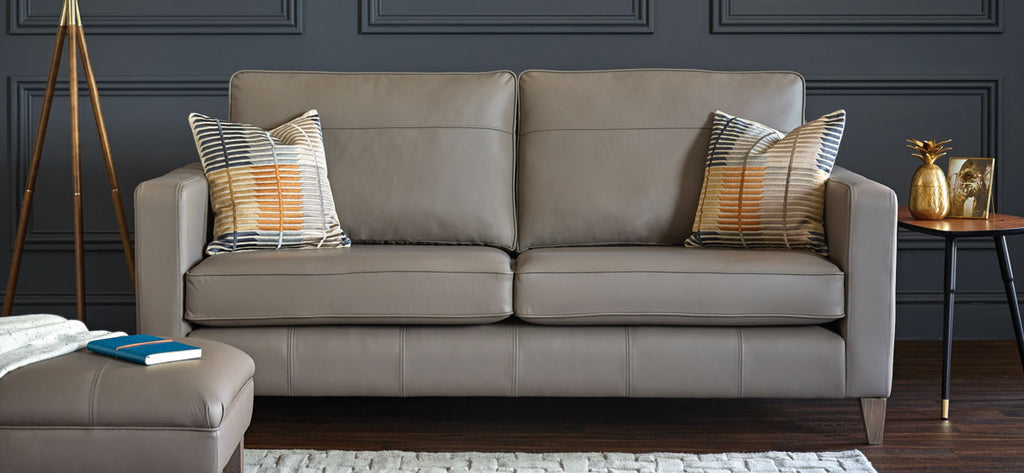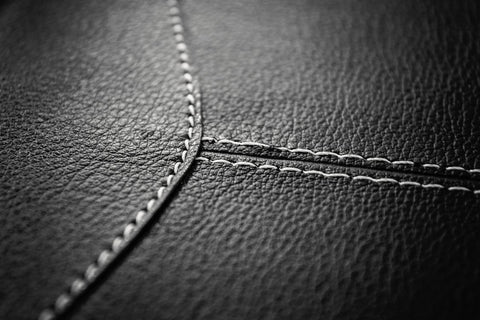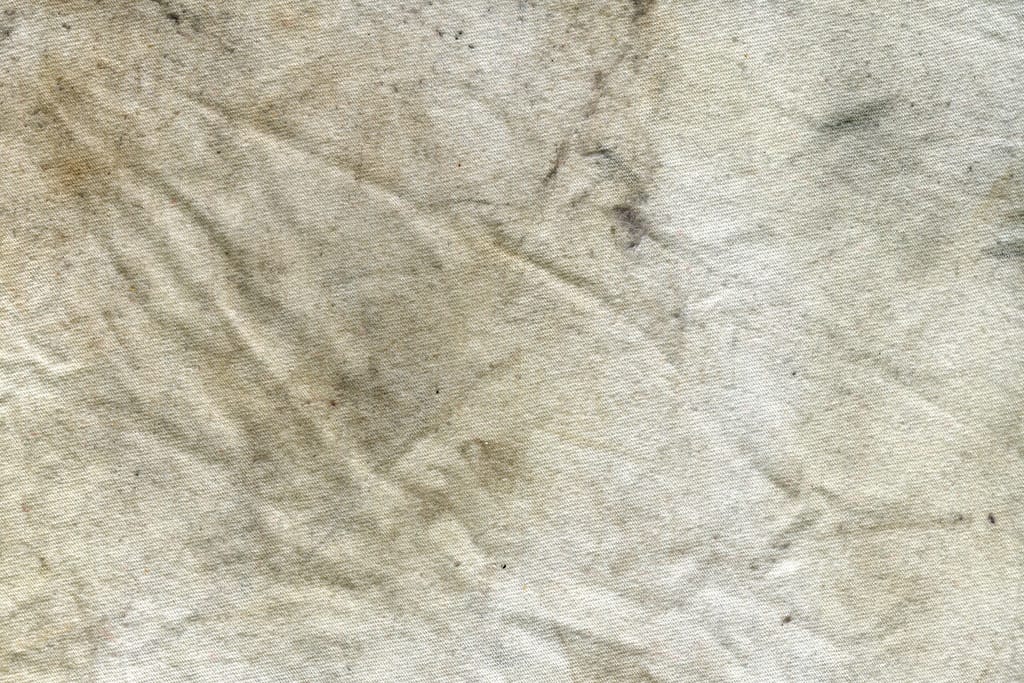Yes, the time has come to get your hands dirty and clean that leather sofa!
You’ve noticed your couch is looking a bit grubby and in need of a good old scrub, or perhaps your last tactic didn’t work out, and now you need some top pointers that’ll work some magic.
Whether your leather sofa is white and hideously exposing all the dirt, or black and naughtily disguising all the grime, you can get your sofa looking squeaky clean. And as furniture gathers a lot of bacteria, it should be cleaned regardless.
Some of us tend to underestimate leather. Although it is a hard-wearing, strong material, leather is a natural product that needs to be maintained with tender, love and care.
The truth is, animal skin is just like ours. When skin is not being looked after properly, it becomes unhygienic, looks unkept, and responds in an undesirable way.
Plus, leather sofas bring a luxurious elegance into our home, and it would be a downer to let it age before its time when you could take advantage of the long-lasting nature leather is destined to have!
With a cleaning routine using the right method and products, you can keep your leather sofa looking fresh and youthful for many years to come!
Read on to find out how...

The Portofino 3-Seater Leather Sofa in Softgrain Grey
WARNING: BEFORE YOU CLEAN YOUR SOFA
SofaSofa does not recommend using any type of cleaning products on all leather furniture purchased from our store.
Please seek specialist advice!
With tons of leather sofas on the market, each sofa is unique and needs to be treated separately from other leather sofas.
From aniline leather to pigmented leather, sofas are crafted in various kinds of leather and with different techniques, and may not contain the same properties.
Before cleaning your sofa, we strongly recommend that you read and stick to your model’s cleaning and care instructions in the manufacturer's guide, as different leather sofas may require their own method of cleaning.
Failing to comply to manufacturer guidelines could potentially put your sofa at risk of irreversible damage.
However, if you’ve misplaced or thrown out your manufacturer’s guide, don't panic! Our cleaning tips below are the safest way to get your leather sofa looking brand-new without putting this precious material at risk of damage.

How to Deep Clean Leather
We won't pretend that sofa cleaning is at all enjoyable, but there is no doubt that you want to maintain its stunning looks and for it to be as durable as it can be!
Although it generally depends on your lifestyle and how often you use your sofa, thankfully, we only recommend cleaning it every 3-5 months for great upkeep and maintenance.
However, if necessary, feel free to clean it a bit more regularly, but try not to get in the habit of cleaning it too much, as this can affect the material and decrease the lifespan of your sofa.
So, here is what you need for deep cleaning (and it’s not much!):
- Vacuum Cleaner with Soft Brush Attachment
- 4 Dry White Microfibre Cloths/ 1 White sponge and 3 Microfibre Cloths
- Leather Cleaning Solution (Preferably Foam)
- Leather Conditioner or Protection Cream
- Bowl With Distilled Water (Room-temperature)
Once you’ve gathered your cleaning tools, you are ready to freshen-up your sofa!
8 Step Leather Deep Cleaning Guide:
1. First, without the soft brush attachment, carefully vacuum in between the crevices and folds of your sofa to remove any debris.
Tip: Do not press the vacuum hose hard on the sofa, as this can form unwanted scratches and marks.
It would be much easier to reach the crevices using a crevice tool attachment, but it isn’t essential.
2. Then, with the soft brush attachment, gently vacuum the entire leather of the sofa.
Tip: Leather is a delicate material, and the soft brush protects the leather from scratches and marks.
3. After, give your sofa a thorough wipe-down with a microfibre cloth to lift most of the dirt and any leftover dust.
Tip: Use a circular motion rather than scrubbing, as this can damage the material, and in some cases, rub off the dye.
With minuscule fibres finer than human hair, a microfibre cloth is able to grab and hold dirt, and reach surface pores and crevices that standard cloths are unable to reach.
Also, microfibre cloths have been scientifically proven to remove a high-level of bacteria, and are capable of cleaning, polishing and dusting without water or cleaning products to remove dirt and germs (and cleaning leather is safer without these liquids!).
White-coloured cloths are more ideal so you can monitor the dirt and avoid any dye-colour transferring on your leather sofa.

4. Once you’ve done that, apply some leather cleaning solution on the sponge or second microfibre cloth.
Tip: Read the instructions on the solution first and make sure it is suitable for your leather sofa!
Do not use harsh soaps, solvents, detergents, and ammonia-based products to clean, as it can cause more damage than stains, such as stripping the colour or protective coating.
A foam solution is preferred, as it produces better results and lessens the chance of marks and streaks.
Using a sponge works better with a foam-type solution, allowing it to become more….well, foamy!
If you do not wish to use water on your sofa or your solution does not need to be diluted, please skip to Step 6.
OR
Add leather solution to distilled water in a bowl.
Tip: If you feel your sofa needs to be cleaned with water, the safest option would be to buy a professional leather solution that can be diluted with water.
Use distilled water, as bottled and tap water have chemicals in it that are harmful to leather.
WARNING - CLEAN AT OWN RISK
Whilst there are many DIY cleaning solutions for leather furniture, vinegar with water is recommended by many, as it has proved to be successful in cleaning leather sofas. The fibre in the leather can actually to these products, weakening the fibre over time and causing long-term, permanent damage.
Although SofaSofa does not recommend homemade cleaning solutions, we can’t promise that you will be on your best behaviour. So, as tempting as this cheaper alternative may be, please make sure you try it on an inconspicuous area on your sofa first to avoid disappointment!
Tip: Just remember that accidental damage is very unlikely to be covered in your sofa’s warranty!
5. Next, moisten the second microfibre cloth in the bowl.
Tip: Ring out the water from the cloth as much as possible, as if your leather couch gets too wet it can dehydrate the material and extract the added oils that maintain its moisture.
Lack of moisture stiffens the leather and causes cracks, just like human skin.

6. Using the microfibre cloth with solution, gently massage a section of the leather sofa to remove the dirt.
Tip: Before cleaning with solution, test in an inconspicuous spot to see if it accepts the solution or absorbs water.
If it reacts to leather solution or absorbs water, stop immediately and seek advice from a leather specialist. Otherwise, if you are happy with the result, proceed and start the cleaning process from the top of the sofa.
7. If necessary, spray solution on a Tampico brush and gently scrub sofa to lift ingrained dirt with ease.
Tip: Wet the Tampico brush in warm water to loosen-up the bristles before applying cleaning solution.
Use a circular motion with light pressure, and increase gradually to get rid of hard-to-remove dirt and marks.
8. Dry section with the third microfibre cloth and repeat Step 6 and 8 until the entire sofa has been cleaned.
Tip: Do not attempt to rinse sofa before drying, as leather is a porous material and will absorb the water.
Also, avoid using a blow dryer or any type of heating device, as it can dry out and dehydrate the leather, eventually causing it to crack and fade.
Conditioning & Rehydrating
Once you’ve cleaned your leather sofa, it’s time to give it a good condition to bring it back to life and restore its beautiful sheen!
Most importantly, conditioning your sofa moisturises and revitalises the leather, filling its pores with nourishing essentials to preserve and protect it from damage, wear and tear, stains, and dehydration.
It also keeps leather smooth and makes it more repellent to spillages, keeping the liquid on the leather’s surface, and preventing penetration and absorption in the material.
SofaSofa recommends conditioning your sofa after every clean to replenish its natural oils and protect it from damage.
3 Step Conditioning Guide
1. Apply leather conditioner or protection cream to microfibre cloth.
Tip: Make sure the conditioner or protection cream is suitable for your leather sofa.
Do not apply too much at once, as a little goes a long way and you do not want to saturate your sofa.
2. After, massage conditioner or protective cream into a section of leather sofa and repeat until the entire sofa has been conditioned.
Tip: Before using the conditioner, test in an inconspicuous spot to see if it accepts the solution.
Use a circular motion and be sure not to miss a spot, so all areas are fully protected.
3. Leave conditioner to air-dry for as long as possible before buffing sofa with the fourth microfibre cloth.
Tip: Buffing gives your sofa a gorgeous sheen, giving it that brand-new look!
Although many people make their own DIY leather conditioners at home, typically using vinegar and an essential oil, we recommend using a professional leather solution.
Whilst this mixture may work for a short period of time, eventually, you may put your sofa at risk of having hideous oil spots, changing in pigmentation and texture, or oxidising.
General Cleaning
As you’d rather be unwinding on your snug sofa than spending time reviving it, we recommend that you wipe-down your leather sofa on a weekly basis with a microfibre cloth to remove dust and avoid dirt build-up, and make the deep cleaning process as quick and easy as possible!
You could even consider using leather wipes to give your sofa a quick clean, or for rapid removal of everyday marks, stains, etc.
If you’re the type that loves a night-in watching your favourite TV shows whilst chomping on some snacks on your sofa, you might want to include your sofa in your vacuuming routine - just don’t forget the soft brush attachment!

Secrets for a Healthy Leather Sofa
Professional leather cleaning products can be purchased from furniture stores or specialists, such as Furniture Clinic.
The better the brand the better the results, so avoid buying cheap brands as you can risk harming your sofa.
To avoid cleaning often, consider adding some of our pretty loose covers, armpads, and throws to protect your sofa and prevent it from getting too dirty.
Now that you know how to get your sofa sparkly clean, grab your cleaning tools and make it happen. We promise you’ll fall in love with your sofa again!

